Dashboard and Case Studies
Energy Consumption and Emissions Reductions
(Indicator #2)
Energy consumption and carbon emissions would be 78% higher without energy efficiency investments
Source: EIA (2022) Monthly Energy Review
DETAILS
Increasing energy productivity is the result of a combination of energy efficiency policies and innovations as well as structural changes in the economy. Had U.S. energy productivity remained at the level observed in 1980, U.S. energy consumption today would need to be more than double its current value in order to achieve the same level of our current economic growth.1 ACEEE analysis estimates that energy efficiency is responsible for approximately 60% of these energy productivity improvements.2
Similarly, the U.S. would have produced 78% higher carbon emissions, or an additional 3,810 million metric tons of carbon dioxide, in 2021 without energy efficiency investments. This highlights the extraordinary scale of energy efficiency as a tool for decarbonization.3
Energy Efficiency is a Low-Cost Resource
(Indicator #12)
Energy efficiency is a cost-effective, reliable, zero-carbon resource
Sources: ACEEE (2021); Lazard (2021)
Source: LBNL (2021)
DETAILS
Energy efficiency allows utilities to meet state energy or emissions reduction requirements, as well as reliably meet its customers’ overall electricity demand. Thus, it is informative to consider energy efficiency as an energy resource: one that is distributed, zero-carbon, and often the most affordable option to satisfy energy needs relative to other generation technologies, even compared with wind and utility-scale solar.
Utilities and other program administrators develop and implement a diverse portfolio of programs that help different customers and sectors save energy using a variety of strategies. The cost-effectiveness of different programs can be quantified through several approaches, including by dividing the expenses by the number of kilowatt-hours saved for a levelized cost of saved electricity. The levelized costs shown above include only the program administrator costs, not any additional costs paid by customers.
Lawrence Berkeley National Laboratory considered the levelized program administrator cost of saved electricity for a variety of utility ratepayer-funded efficiency program types in 2018, finding that costs ranged from residential lighting rebate programs (1.2 cents/kWh) to HVAC retrofits (8.6 cents/kWh). 4
Energy Expenditures And Cost Savings
(Indicator #5)
Efficiency investments have reduced today’s energy expenditures by approximately $800 billion (2020$)
EIA (2022) Monthly Energy Review
Historical Tables, Budget of the United States Government, Fiscal Year 2022 (2021). Budget FY 2022
DETAILS
Energy efficiency has also led to enormous bill savings across the economy. Based on some simple assumptions,5 the chart shows the total energy expenditures across the U.S. economy from 1980 to 2020, and the energy cost savings each year due to energy efficiency investments since 1980. As energy prices overall dropped since 2008 (until this year), the amount of energy saved each year grew, and the dollar savings have remained around $800 billion each year.
To put this number in context: if we had had the same level of economic growth without these savings, energy spending would have been 77%, or $774 billion, higher in 2020.
Policy Impact: Federal Appliance Standards (Indicator #25)
Policies for appliance efficiency are saving 14% of the total electricity generated in the U.S., and 6% of delivered natural gas
Source: ACEEE & ASAP (2022)
Source: ACEEE & ASAP (2022)
DETAILS
Federal appliance standards ensure a base-level efficiency for all appliances on the market and have led to large-scale energy savings of both electricity and natural gas since 1990. These savings add up to enormous benefits for U.S. households and businesses. A typical household saves about $500 per year on utility bills because new household appliances and heating, cooling, and lighting products comply with minimum standards.6 Estimates suggest the federal appliance standards program saved nearly 680 TWh in 2021 relative to efficiency levels without standards, which is over 16% of the total electricity that was generated in the U.S. in 2021 (4,115 TWh).7
Building Performance Standards (Indicator #36)
Tremendous room to grow
U.S. Cities and States with Building Performance Standards in Place
IMT (2022) Building Performance Standards
Jurisdictions in the National Building Performance Standards Coalition
Contributing Cities and Counties
Annapolis, MD
Aspen, CO
Atlanta, GA
Boston, MA
Boulder, CO
Cambridge, MA
Chicago, IL
Chula Vista, CA
Columbus, OH
County of Los Angeles
Denver, CO
Evanston, IL
Fort Collins, CO
Grand Rapids, MI
Ithaca, NY
Kansas City, MO
Los Angeles, CA
Milwaukee, WI
Montgomery County, MD
Montpelier, VT
New York, NY
Orlando, FL
Philadelphia, PA
Pittsburgh, PA
Portland, OR
Prince George’s County, MD
Reno, NV
Sacramento, CA
San Diego, CA
San Francisco, CA
Savannah, GA
Seattle, WA
St. Louis, MO
Washington, DC
DETAILS
While building efficiency codes are an effective policy solution for improving building energy performance, codes only impact new construction or alterations, which only slowly affects the total building stock. As of 2018, roughly 91% of all commercial buildings were over eight years old (built before 2010).8 Typically, building structures last 70 to 80 years.
A building performance standard (BPS) is a policy that sets energy use or greenhouse gas emission targets for existing buildings. BPS policies can complement codes for new buildings and can be adapted based on the jurisdiction. BPS policies typically set increasing targets over time, with timelines often varying based on the size of the building or equity considerations, such as allowing extended timelines for compliance for affordable housing (e.g., St. Louis and DC).9
In January 2022, the federal government launched the National BPS Coalition. Over 30 participating jurisdictions are committed to passing a building performance policy by Earth Day 2024.10
Case Studies
System-level Efficiency Gains for Tennessee Community

Source: Trane (2022) Image: Pexels (2018), Grey Concrete Building
Opportunity
A county located outside of Nashville, Tennessee is home to rich southern tradition and beautiful rural countryside. The county did not want to have to increase taxes to manage renovations of its 14 government buildings, which included their treasured and historical courthouse. Many of the aged buildings were costing the county heavy maintenance fees and high electricity bills. In fact, up to 30% of the energy used in a commercial building is wasted.11 This wasted energy increases with poor energy management systems, aged and inefficient HVAC systems, and drafty building envelopes. 11 towns and a population of around 70,012, the county partnered with Trane to create a holistic energy management plan for its ageing building infrastructure.
Solution
To ensure the county’s building retrofit efforts were a success Trane opted for a complete building audit with guaranteed energy savings. Through Trane’s Building Advantage portfolio service multiple energy conservation measures (ECMs) were proposed to the county. These included building envelope improvements by replacing damaged and drafty windows and doors, upgrading fluorescent lighting and installing low-flow devices to the 60+ year-old plumbing units. The buildings’ HVAC units were surveyed and replaced with high-efficiency units where necessary. Trane Tracer SC building automation system (BAS) was also installed to allow the county the ability to directly manage its energy usage. Trane provides ongoing staff training to educate and support the optimization of the government building performance.
Outcome
The local Tennessee county not only avoided increasing resident taxes to implement this guaranteed energy savings project, but now the county’s ECMs cost savings can be re-distributed back to where it really matters – its people and community. With improved indoor air quality (IAQ) throughout its governmental buildings, officials can breathe more easily as they meet the community’s needs. In the first year since project completion the county saved more than $200,000 from energy savings and more than $8,000 from avoided operational and maintenance fees. Partnering with Trane, the county is doing its part for future generations to come.
City in Kentucky Upgrades Municipalities with Energy Savings Project

Source: Trane (2022) Image: Pexels (2020), Woman Discussing a Building Project with Colleagues
Opportunity
Many cities around the world have municipal buildings that were constructed with now outdated efficiency standards and are using more energy than necessary to remain in operation. Wasting energy is often wasting money. A certain city in Kentucky is one of the many towns looking to improve the efficiency of its buildings.
Solution
Through a performance contract with the city, Trane was able to provide physical upgrades to city-owned buildings, like improved insulation, LED lighting and fixture updates, and high-efficiency HVAC equipment with controls and smart meters. These improvements included the city’s town hall, street poles lighting up downtown, its community center, a live event venue and even the water and wastewater treatment facilities. Trane’s team of energy engineers also monitor and support the HVAC systems’ real-time response to daily needs to manage electricity consumption and demand effectively while still meeting the comfort and air quality needs for the buildings.
Outcome
The physical improvements are ongoing, and the energy performance guarantees are on target to save the city $16.5M over the next 20 years. The reduced cooling and heating loads from envelope improvements, coupled with the reduced electricity use from updated lighting and HVAC systems that are maintained at peak efficiency produce an annual savings of 622 MWh. The electricity savings help the city avoid 441 mtCO2e on an annual basis.
Highlights
Results
- Targeted to save the city $16.5M over the next 20 years
- Annual energy savings of 622 MWh
- Saves 441 mtCO2e on an annual basis
Tools
- Improved insulation
- LED lighting and fixture updates
- High efficiency HVAC equipment with controls and smart meters
A School District in Southern California: Green Building Infrastructure for the District

Source: Trane (2022) Image: Pexels (2020), Woman in Red Long Sleeve Writing On Chalk Board
Opportunity
In sunny California resides a school district composed of 32 schools and supporting facilities. The district’s mission is to enrich its more than 25,000 students through innovative thinking and problem solving. This is shown through its scholarly approach to education and efforts in STEM which include 26 school gardens and 16 citrus groves. Partnering with Trane the school district can lead by example within its own community by improving building indoor air quality (IAQ) and reducing carbon emissions. With the help of prop 39, a government-funded program the district was awarded funding to improve the total energy efficiency of its buildings. The district already had 8.4 MW of solar power, covering 80% of the district’s electricity demand, giving Trane an opportunity to help further reduce the districts reliance on the electric grid by maximizing the use of its solar arrays.
Solution
The school district chose Trane’s performance contracting with guaranteed energy savings, ensuring the school would realize cost savings that could be re-distributed to further the school’s academic mission. Trane’s comprehensive solution included internal and external LED lighting retrofits for 24 of the buildings, high-efficiency HVAC heat pump upgrades in 10 of the schools, 54 high-efficiency transformer replacements, and plumbing upgrades for 23 buildings. All HVAC upgrades included Tracer SC control systems. The long-term partnership included 4 phases that were completed in 2020, Trane continues to support through tracking guaranteed energy savings.
Outcome
Savings since project completion include around 12,759 MWh saved, close to 17,451 Therms avoided and about 33,214 kilogallons water saved. The total project cost savings have amounted to $1.7 M and will continue to grow in the coming years. These cost savings allow the district to re-allocate funding back to enriching students’ education, that otherwise would be used to power the buildings. The energy saved since project completion is equivalent to the school district avoiding 9,042 mtCO2e. Upgraded equipment combined with pre-existing solar panels provides a real-world example to teach students about the impact and importance of green building infrastructure. Several schools within the district were awarded California Green Ribbons in 2020-2021 for their rich STEM education and best practice green building design.
Highlights
Results
- 12,759 MWh saved
- 17,451 Therms avoided
- 33,214 kilogallons of water saved
- $1.7 million in cost savings
- 9,042 mtCO2e worth of emissions savings
Tools
- Internal and external LED lighting retrofits for 24 of the buildings
- High-efficiency HVAC heat pump upgrades in 10 of the schools
- 54 high-efficiency transformer replacements
- Efficient plumbing upgrades for 23 buildings
- All HVAC upgrades include Tracer SC control systems
An Illinois School: Retrofit for Efficiency

Source: Trane (2022) Image: Pexels (2016), White Graphing Notebook
Opportunity
A school in Illinois had not been renovated since its mid-60s construction, and the school’s older heating, ventilation, and air conditioning (HVAC) system had outlived its heyday. The school’s outdated infrastructure system also failed to align with the district-wide commitment to sustainability. Well past its prime, the building’s HVAC system was proving unreliable, impeded building comfort and provided a less-than-ideal learning and working environment. The system also was proving increasingly costly to operate and maintain.
Solution
Working with Trane, the district explored various funding options and ultimately selected a $2 million grant opportunity with the Illinois Clean Energy Community Foundation (ICECF). The grant required transforming the facility to a net-zero building. Among the solutions included a photovoltaic solar panel system on the roof designed to offset 100 percent of the building’s annual electricity consumption. The project also added a new dedicated outdoor air system (DOAS) combined with a new highly efficient electric variable refrigerant flow (VRF) heating and cooling system with heat recovery, removing the need to rely on fossil fuels for heat. A new building automation system, accessible both onsite and remotely, was selected to provide centralized control of building systems while monitoring temperature and electrical loads. There are also now educational tools provided that allows for students and teachers to enhance their understanding of energy efficiency.
Outcome
The renovated school is the area’s first net-zero facility. The building is on track to save more than $32,000 a year in annual gas and electricity costs while offering optimized indoor air quality and reliable, energy efficient performance. The building’s solar panels, combined with other energy saving design elements, are successfully offsetting the building’s annual electricity consumption. These efficiency enhancements helped the school fulfill all ICECF grant requirements, achieving net-zero status.
Highlights
Results
- More than $32,000 in annual savings
- Optimized indoor air quality
Tools
- A photovoltaic solar panel system on the roof
- New dedicated outdoor air system (DOAS)
- Highly efficient electric variable refrigerant flow (VRF) heating and cooling system with heat recovery
educational tools - Building Automation System (BAS)
Footnotes
- EIA (2022), Monthly Energy Review
- ACEEE (2015), Energy Efficiency in the United States: 35 Years and Counting.
- This chart assumes the same energy intensities as the chart above and uses the actual emissions intensities per quad of energy use for each year.
- LBNL (2021) Still the One: Efficiency Remains a Cost-Effective Electricity Resource
- U.S. Census (2022), Population Estimates
- ACEEE (2017), Energy-Saving States of America: How Every State Benefits from National Appliance Standards
- EIA (2022) Electricity Data Browser
- CBECS (2019) 2018 CBECS Survey Data
- IMT (2022) Comparison of U.S. Building Performance Standards
- National BPS Coalition (2022) About the National BPS Coalition
- DOE (2022), Take Action to Save Energy in Commercial Buildings

